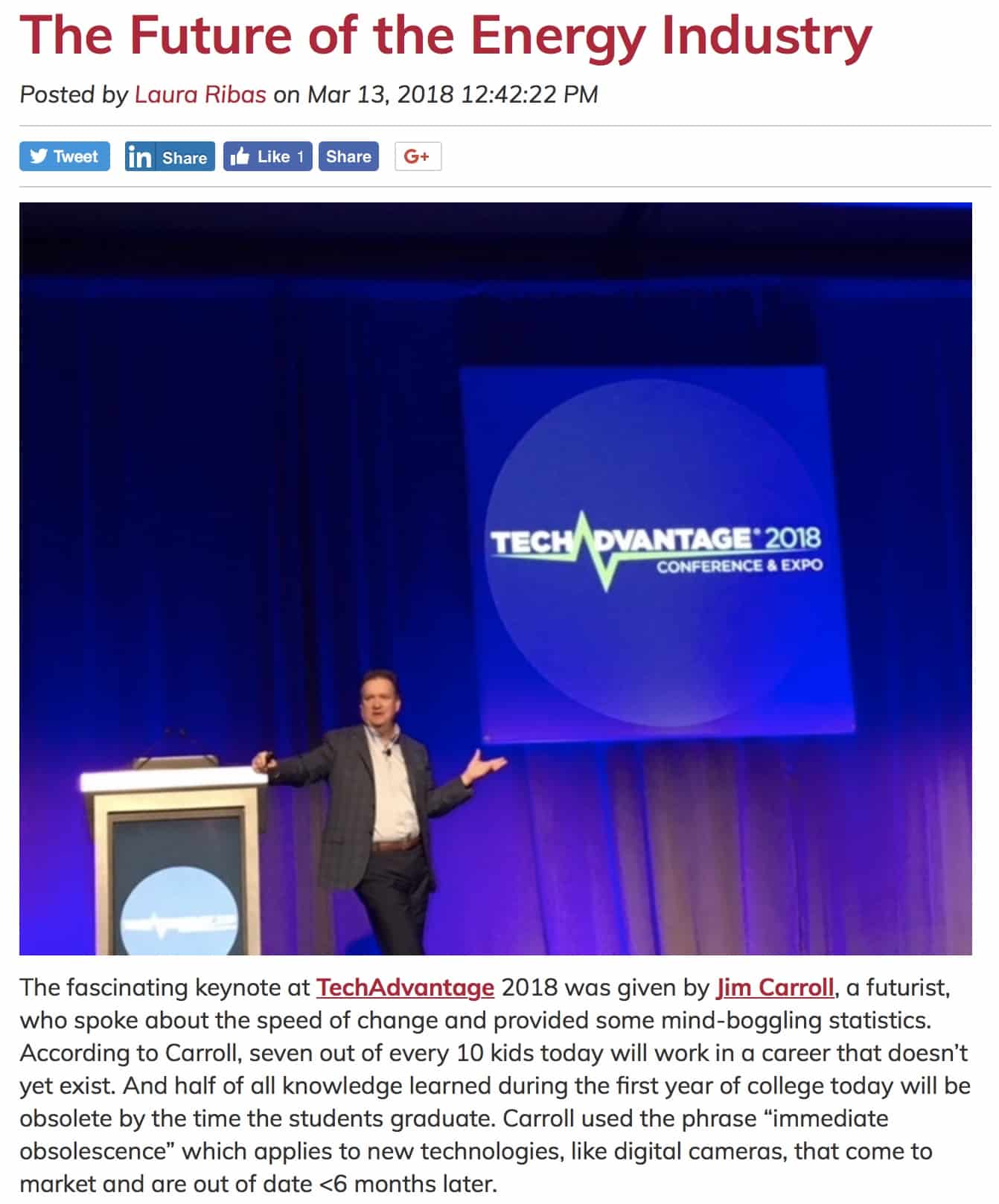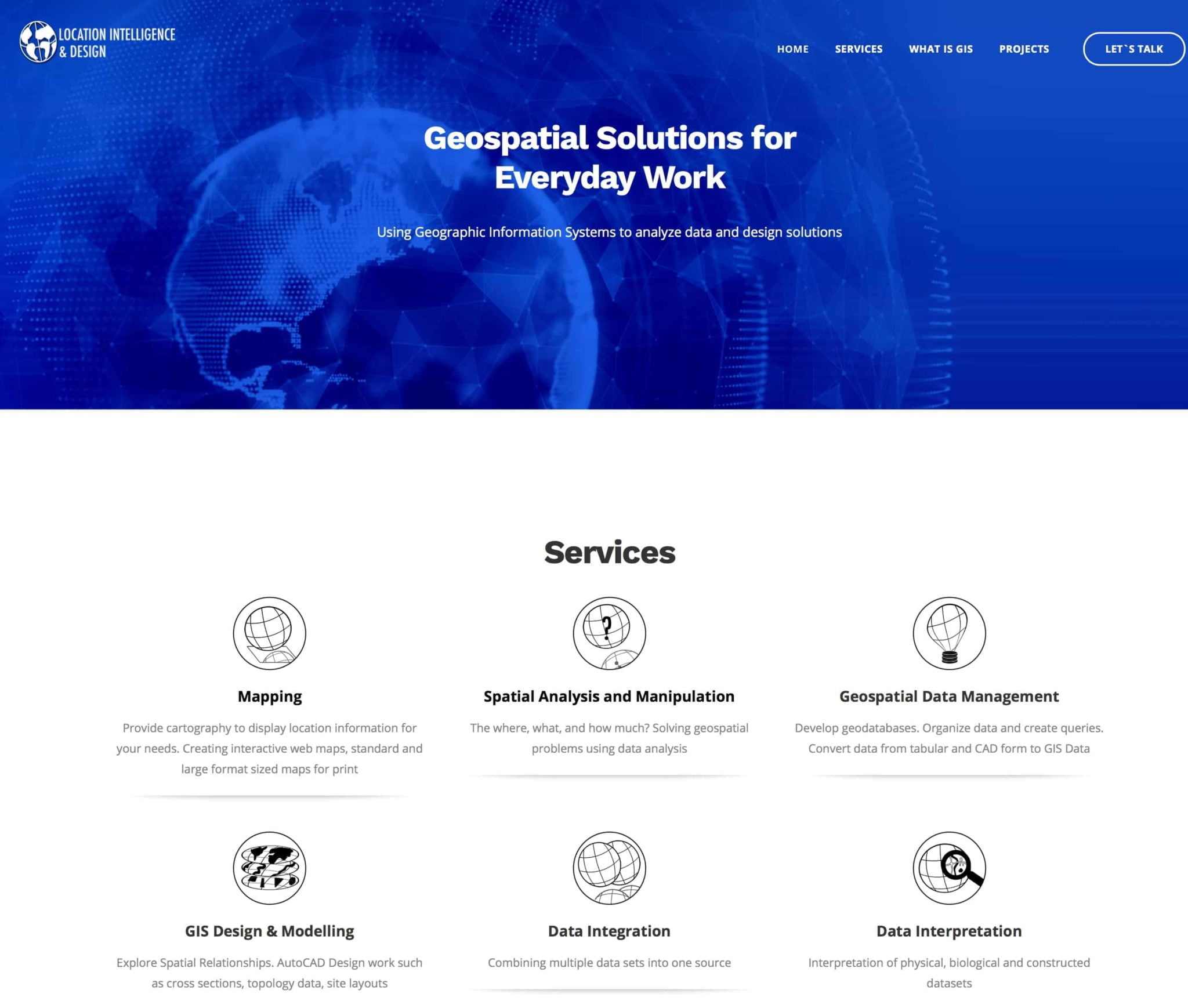Despite the fact that I’m a futurist with a relentless focus on innovative thinking, I’m probably as guilty as the next person in making quick judgement on people and companies – particularly with respect to the scope of what they do today compared to yesterday.
So it was when I saw that a company named Lewis Tree Services wrote a blog post about my recent keynote for the annual National Rural Electrical Cooperative Technology Show in Nashville. Read their post here; you’ll also find it below.
Hmm, I thought – what is a tree company doing at an energy conference, and why would they blog about my keynote with an observation on the future of that industry? After all, what do these people do – trim and cut trees?
In my keynote, I did speak about the emergence of new careers – including, location intelligence professionals! Watch it here:
That’s the type of limited thinking that I often accuse my clients of falling prey to! All too often, we miss the signs of significant change in an industry, unless we actually spend some time to work in that industry. Such it is with the cutting and clearing of trees….. who would have thought! Well, I should have!
I began reading the post (which does a great job in summarizing my talk!), and then started browsing their Web site. Tree cutting? It’s no longer what it was. It’s bound up in spatial intelligence – location is everything. This organization provides utility, i.e. power companies, i.e. those at the conference, with intelligent mapping services that can provide for better overall municipal risk management among other things. A key line in their service offerings caught my attention:
“The heart of the Intelligent Vegetation Management approach is a philosophy of leveraging investments in GIS, outage management, customer information and ERP systems to connect vegetation management operations into technology ecosystems – yours and ours.”
Of course! Intelligent vegetation management by location intelligence professionals. Of course their industry has transformed into a technology driven industry – in which tech provides a pathway to the delivery of all kinds of innovative services and capabilities. And the fact is, this transition has been underway for a long time ; too many of us don’t spend time thinking just how quickly EVERY industry is being transformed.
Here’s the fun part – my entire morning before reading this blog post has been bound up in properly catching the essence of location intelligence as a professional service. Backstory: I’ve been talking about the emergence of the ‘location intelligence professional’ as a critical emerging career path for the last 20 years. Someone must have been listening, because my oldest son Willie Carroll went on to get a university degree and then a post-graduate college certificate in that very field!
And just as I was reading this blog post from Lewis Tree, I’m working with Willie in the home office as he rolls out his new freelance GIS company, Location Intelligence & Design.
Willie’s key skill set includes collection and interoperation of location / geospatial information with the leading such technology from ESRI, ArcGIS. Lewis Tree? The heart of their Intelligent Vegetation Management service is based upon ESRI’s ArcGIS!
I love this world. There is just so much coming together all at once.
I also love this line in their blog post: “We need to learn what we don’t know and fill our knowledge gaps.” Yup, me too!
The Future of the Energy Industry
Posted by Laura Ribas on Mar 13, 2018 12:42:22 PM
The fascinating keynote at TechAdvantage 2018 was given by Jim Carroll, a futurist, who spoke about the speed of change and provided some mind-boggling statistics. According to Carroll, seven out of every 10 kids today will work in a career that doesn’t yet exist. And half of all knowledge learned during the first year of college today will be obsolete by the time the students graduate. Carroll used the phrase “immediate obsolescence” which applies to new technologies, like digital cameras, that come to market and are out of date <6 months later.
The future belongs to those who are fast.
We’re in the midst of unprecedented change with more change expected in the next few years than has occurred over the last 150 years. The world will look vastly different in ten years than it does today.

The world is becoming hyper-connected and business models are shifting with this massive connectivity. Our smart phones are now digital cameras, credit cards and GPS devices. We can manage the heat and security of our homes from afar. Our kitchen appliances are connecting with food packaging and retailers. Home sprinkler systems have moisture sensors (because why water when we don’t need to?). We now have medical tricorders that provide an instant readout of our healthcare and physical condition. The science fiction of Star Trek and the Jetsons is here today.
When Napster introduced the ability to download MP3s, the music industry was threatened as their business model changed. The same will be true for utilities and those serving them. Will we see change as a threat or an opportunity?
Smart businesses will see change as an opportunity.
What does this new world look like? It’s a world where big data and analytics are key. It’s a world where precision farming is conducted by drones analyzing plant health, soil composition and more. Where real-time information is provided to vehicles to inform lane changing. Where street lights monitor air quality and offer car charging stations. Where highway control is intelligent. Where we’ll have 24/7 solar energy even when it’s dark outside.
Carroll believes that these are near-term, not long-term, trends. That self-driving trucks are five years away. That flying cars are simply drones scaled up in size and able to carry people.
Moore’s law of innovation velocity is happening before our eyes. The advancements in battery technology are staggering (and small always beats big).
And Carroll believes that we’ll achieve grid parity faster than we think. Think: portable charging stations. Think: glass in buildings that generates electricity. Think: growing solar cells in plants. (Check out this article that highlights a new thermal resonator device from MIT that can generate energy anywhere using natural temperature changes.)
With grid parity, customers will generate their own energy and share it with each other via micro grids. According to Carroll, the micro grid is not a fringe idea; it is fundamental to the future. (Check out this ComEd press release sharing that they’ve been approved to construct one of the first utility-scale microgrid clusters in the nation.) Think of Napster but for energy: cooperative energy networks. Distributed technology resources are growing three times faster than other technologies. Advanced technologies will reshape the industry and edge thinking dominates.
By 2020, every industry will be a:
- Software industry
- Technology industry
- Insurance industry
- Battery industry
Maytag used to sell appliances. Now equipment manufacturers sell service levels and uptime using predictive diagnostics.
Utilities are also becoming insurance companies, hedging customers against risk using real-time data to eliminate outages. Blockchain technology, like that used for Bitcoin, will have a massive impact on smart grid technology transforming the architecture of the grid itself.
We’ve seen the costs of LiDAR collapsing from $75K to $100. Carroll joked that pretty soon they’ll be selling LiDAR packs at Dollar General. A massive shift in location-based services is underway. And mapping requires location intelligence professionals.
And with customers using smart thermostats like Nest and Ecobee, utilities can also provide innovative ways for customers to receive rebates. Think of today’s kids. They don’t know mainframes and DOS. They’re wired, collaborative and global. They’re gamers. What happens when gamers buy houses with Ecobees? They compete against their neighbors to win energy rebates.
Devices with participatory data are the future.
The grid is a complex data engine and data is the new oil in energy.
We need to learn what we don’t know and fill our knowledge gaps. To be prepared requires garage-like thinking. We need to ask ourselves, are we leaders or followers? And how quickly can we change?
At Lewis Tree Service, we believe that one of the benefits of introducing our Intelligent Vegetation Management solution as a forerunner in the industry is that it enabled us to become more agile, flexible and customer-centric when it comes to technology and innovation.
We’re big fans of Carroll’s adage: Think big, start small, scale fast.







GET IN TOUCH
Jim's Facebook page
You'll find Jim's latest videos on Youtube
Mastodon. What's on Jim's mind? Check his feed!
LinkedIn - reach out to Jim for a professional connection!
Flickr! Get inspired! A massive archive of all of Jim's daily inspirational quotes!
Instagram - the home for Jim's motivational mind!